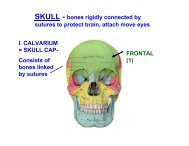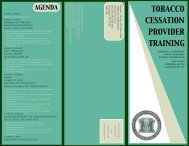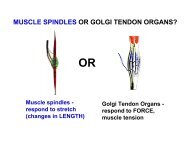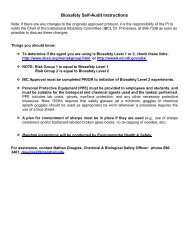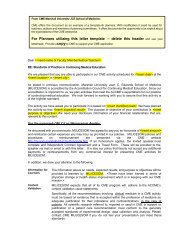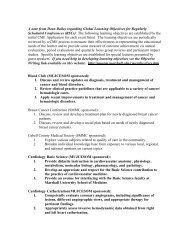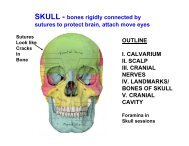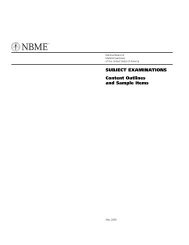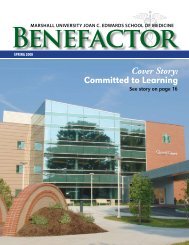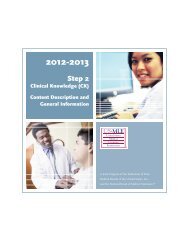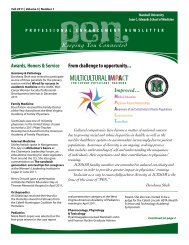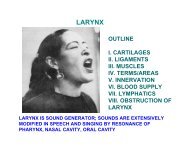FA 5 Progress Report WV-INBRE - Joan C. Edwards School of ...
FA 5 Progress Report WV-INBRE - Joan C. Edwards School of ...
FA 5 Progress Report WV-INBRE - Joan C. Edwards School of ...
- No tags were found...
Create successful ePaper yourself
Turn your PDF publications into a flip-book with our unique Google optimized e-Paper software.
Program Director/Principal Investigator (Last, First, Middle): Rankin, Gary O 63We note that a small fraction <strong>of</strong> affected members may not share a candidate variant becausethese individuals may be phenocopies (individuals who have the disease because <strong>of</strong> environmentalbut not genetic causes), or have inherited an alternative susceptibility variant from a married-inindividual. Further, some <strong>of</strong> the unaffected relatives could have a candidate variant because theyare nonpenetrant carriers.Outcomes: FCH is thought to be an oligogenic disorder. By sequencing the exomes <strong>of</strong> three ormore 2° or 3° individuals in a given family, we should be able to identify the major susceptibilitygenes. Further by sequencing the exomes <strong>of</strong> several unrelated families, we may find alternative oroverlapping sets <strong>of</strong> susceptibility genes.Confirmation <strong>of</strong> causality: Identification <strong>of</strong> one or more FCH candidate susceptibility genes by thisfiltering process should be viewed with some caution. Some initial confirmation can be achieved byreview <strong>of</strong> the candidate gene’s metabolic function and its relevance to the dyslipidemic phenotype.Long term studies should include replication <strong>of</strong> the FCH phenotype in animal models containing theappropriate variant transgenes. Funds for the animal studies are not budgeted and would need to bepart <strong>of</strong> a future proposal.Alternatives to whole exome sequencing approachWhole exome sequencing is an efficient strategy for discovering the genetic causes <strong>of</strong> Mendeliandisorders given that (1) most known variants disorders disrupt protein coding sequences, (2) alarge fraction <strong>of</strong> rare variants are predicted to be deleterious and (3) there are now ten Mendeliandisorders that have been solved by exome sequencing [8, 9 and J. Shendure, Illumina Webinar2010). Although a number <strong>of</strong> investigators now view whole exome approaches as viable means <strong>of</strong>finding susceptibility in polygenic and multifactorial disorders, it is possible that we will not findappropriate candidates because (1) no variants are identified that are shared by a preponderance<strong>of</strong> the affected members or (2) we are not able to reduce the number <strong>of</strong> candidates to anappropriate size. In the former case, the failure to identify shared genes may stem from thepresence <strong>of</strong> susceptibility variants in promoters or regulatory sequencers. Whole genomesequencing could be used to identify those variants but the cost would be prohibitive (at least at thistime). Potential solutions would include seeking additional funding or finding a collaborator who iswilling to absorb the cost. In the latter case, we may employ linkage analysis on single families toidentify candidates <strong>of</strong> interest. We may also take steps to merge our exome data with other studiesin an effort to reduce the pool <strong>of</strong> variants to a manageable number.4. Materials and Methods:Human Subject Enrollment and FCH Phenotypes:We recruited FCH families who met adult inclusion criteria established by previousinvestigations or our criteria for FCH families with a juvenile proband. Human subjects wereenrolled according to approved Institutional Review Board (IRB) protocols from the following <strong>WV</strong>hospitals or clinics: Charleston Area Medical Center, the Department <strong>of</strong> Adolescent Medicine at theUniversity <strong>of</strong> Kentucky (UK), <strong>WV</strong>U Department <strong>of</strong> Pediatric Cardiology and Valley Health Systems.FCH families were recruited by two primary mechanisms: (1) The Coronary Artery Risk DetectionIn Appalachian Communities (CARDIAC) Project is a population-based and high-risk individualizedprogram designed to raise awareness <strong>of</strong> CAD risk factors in the community and identify individualsat high risk for premature CAD. Dr. William Neal, CARDIAC program director, contacted adultsfrom prospective families through the <strong>WV</strong> lipid clinics to initiate the enrollment process. Thisrecruiting mechanism mainly provided families with juvenile probands. (2) We also recruited FCHfamilies through Charleston Area Medical Center (CAMC), UK and Valley Health System (VHS).Prospective FCH probands were identified by chart review or by physician referral. This processprovided both adult and juvenile FCH families.FCH families were ascertained by identifying probands with one <strong>of</strong> two phenotypes.PHS 2590 (Rev. 06/09)Continuation Format Page



